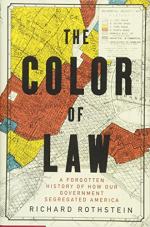|
This section contains 584 words (approx. 2 pages at 400 words per page) |

|
The Color of Law: A Forgotten History of How Our Government Segregated America Summary & Study Guide Description
The Color of Law: A Forgotten History of How Our Government Segregated America Summary & Study Guide includes comprehensive information and analysis to help you understand the book. This study guide contains the following sections:
This detailed literature summary also contains Topics for Discussion on The Color of Law: A Forgotten History of How Our Government Segregated America by Richard Rothstein.
The following version of the book was used to create this study guide: Rothstein, Richard. The Color of Law: A Forgotten History of How Our Government Segregated America. Liveright Publishing Corporation, 2018. Paperback edition.
Racial segregation in residential settings across the United States is the direct effect of law and policy-making decisions on the part of federal, state, and local governments, this is known as de jure residential racial segregation. However, there is a commonly held misbelief that segregation is the result of the choices and actions of private individuals and organizations, this is known as de facto residential racial segregation.
De jure residential racial segregation took place across the United States, even in the San Francisco Bay Area. The policies implemented by the federal government during World War II created a pattern of segregation in the Bay Area that still exists today. If this could happen in the most inclusive, progressive city in the country, it could happen anywhere in America.
The Federal Housing Administration (FHA) used its ability to fund developments to create segregated neighborhoods by only funding projects that explicitly barred home sales to African Americans. Additionally, the FHA refused to insure mortgages for African American homebuyers, limiting the ability for African American families to own their own homes. Local governments began implementing racially motivated exclusionary zoning ordinances that restricted where African Americans were able to live in American metropolitan areas. Exclusionary zoning practices continued even after the explicit practice of race-based zoning was ruled unconstitutional.
Following the Russian revolution, the U.S. government attempted to get white families invested in the goals of capitalism by helping them own their own homes. However, many of the programs and opportunities available to white homebuyers were not available to African American homebuyers. As new developments were built and homeownership grew, many neighborhoods and homeowners began implementing restrictive covenants, which restricted the future sale of homes to African Americans and other groups. The Supreme court first upheld the legality of restrictive covenants, but later reversed the ruling because the enforcement of these covenants required state action.
The perpetuation of the myth that African American residents caused home values to decline in previously white neighborhoods, blockbusting practices, and the growth of suburbs led to large numbers of white homeowners leaving urban areas. The Internal Revenue Service (IRS) misused its power to grant and revoke tax-exempt status to not-for-profit organizations and allowed organizations that furthered the cause of de jure segregation to benefit from government tax exemptions.
In addition to the actions of federal and state governments, local governments used numerous techniques to encourage de jure residential racial segregation, including the condemnation of lands, zoning, and the building of roadways. Governments at all levels explicitly and tacitly endorsed violence as a tool to terrorize and intimidate African Americans and White activists who supported integration efforts.
In addition to explicit barring from certain sectors of the housing market, federal, state, and local government actions restricted the ability of African American workers to earn the same wages as their white coworkers. The segregation of unions, unfair assessments of property values, and cost of commuting prevent African American households from accruing enough wealth to participate fully in the housing market.
The history and legacies of de jure residential racial segregation are critical to making progress, but are not widely understood by Americans. American society must learn about the history of segregation and work to enact policies that actively reverse the harmful effects of de jure residential racial segregation.
Read more from the Study Guide
|
This section contains 584 words (approx. 2 pages at 400 words per page) |

|



